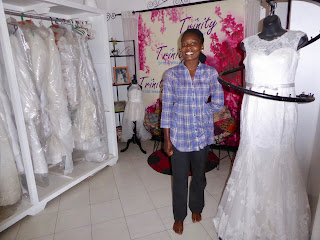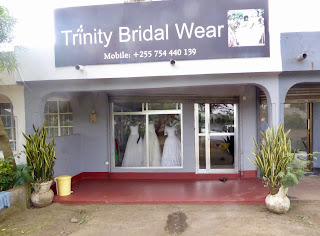There is nothing much to report about for Tuesday, except that late in the afternoon, Beatrice came from the kitchen with a plate of small deep fried “fritters—looking a little like hush puppies—for us to try. She told us they were bagia, which are made with lentil flour. (A recipe I found calls for chickpea flour.) They were savory rather than sweet and quite delicious. I had never had a bagia before, which seems odd since we have come here for so many years. Or maybe I had had them and just didn’t know what I was eating. I certainly intend to eat more before we leave this year.
Wednesday seemed normal with the usual reading, blogging and emailing until Maso came and told us that his brother wanted to drive us out to see the house that Mama is having built for herself out near Njiro. Of course, John is always interested in seeing construction, and I wanted to see the house Mama was going to move into when she “retires” or whatever she calls leaving the family home here on the Kundayo compound. Mary Lou wanted to come, too, and so at 1:30, we all piled into Mama’s car, and Geoffrey drove us out past Njiro to the building site.
The first thing I noticed was the usual cement block construction which looks as if it can never be transformed into a well-finished house. Houses here are usually built over a fairly long time, whenever there is enough money for more work on them, so I wasn’t surprised that there was still a lot of work to be done before this house is finished. Likely Mama’s house won’t be completed for at least two or three more years. I was most surprised at the size of the house; it will have 5 bedrooms, each with its own bathroom. When we are older, we usually downsize, but Mama is building a larger house so that she can host her children and grandchildren. So, she has two large bedrooms on the main floor, where the sitting room, dining area, and kitchen are, and three bedrooms upstairs for her guests. In addition to this main house, there is also a very generous dada house in back for the house girls to live in. It was the largest and best designed dada house I’ve seen so far. I joked that I would come and be a dada so I could live in such a nice place.
 |
| Front view of Mama's house. Only the first floor is being worked on now, but a second storey will be added. |
The large dining area and kitchen are central to the first floor.
 |
| The back of the house as it is now. |
 |
| Hard at work on the wall. |
 |
| The dada house at the very back of the lot. |
There were three workers on site building a wall. It looked like very dirty, hard work, and progress seemed painfully slow. However, with the cement blocks weighing about 35 lbs. each, it would have been difficult to lay them quickly.
I noticed some spectacular rocks in a pile of ordinary rocks and got super excited. Geoffrey said they were rocks that he and Maso had bought in order to find rubies. I knew that the Masai mine rubies, but I had never seen the minerals in which the rubies are embedded before.
I was super excited and gathered several specimen which had traces of ruby formations. Maso told us later that he and his brother had bought a couple truck loads of big rocks from the ruby mining site near Longido and then broke them apart looking for rubies they could sell. With the first truck load, they did very well, but with the second truck load, they just broke even and decided they had had enough rock cracking. I didn’t care about finding any rubies; I just wanted some of the leftover rock pieces.
 |
| The surprise rocks. |
 |
| I was very excited. |
 |
| There were many smaller specimen, too. |
After we finished our time at Mama’s construction site, we drove further out to the family’s shamba, a three-acre plot of land on which they usually grow corn and other crops for themselves. Many people have shambas back in their villages and the crops grown there help city people supplement their food supplies, especially corn. This year, however, nothing had been planted on the Kundayo shamba because the family is now planning a different use for the land. The city of Arusha keeps spreading out, and a new ring road is being built to the south of the city. The Kundayo’s shamba is very close to this new road and is thus now a hot property for development. So, their plan is to build a house for Maso and then a number of smaller rental houses on their land. The view of the hills around Arusha is definitely a plus at this location, too.
After our stop at the shamba, Geoffrey drove us onto a completed section of the new road which connects with the Njiro Road and we headed back home—sort of. Just after we passed the Njiro Complex. he turned left onto an insignificant dirt road and back beyond the stores on the main road to a small cafe owned by his wife. It was impeccably neat and clean, and we got to meet Mama Sidney and the two younger sons. We had soft drinks—Mary Lou’s first Stoney—and then drove out again to Njiro Road, but not home yet.
 |
| Relaxing at Mama Sidney's cafe. |
Just a little further away on the main road, we stopped to see two shops the Kundayo family owns and leases out. The one shop is a bridal rental shop, which specializes in white frilly wedding dresses, and the other shop was being repainted and prepared to become a dress shop. We had an interesting visit with the manager of the bridal shop, who certainly seems to know her business, but I really wonder if there is enough business for her to make it financially. Tanzanians are very entrepreneurial, but many small businesses come and go very quickly.
 |
| Let's hope Judy succeeds. |
Finally, we did return to Kundayo, ending a truly interesting tour of more of the Kundayo business empire. They are a great example of what an enterprising family can accomplish when they all work together.
John had decided that we should have kuku na chipsies (chicken and french fries) for dinner, which pleased me greatly. We also steamed some broccoli so as to have something green with our meal.

No comments:
Post a Comment